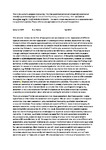Reflections on assessment, diagnosis and formulation
| dc.contributor.author | dallos, rudi | |
| dc.date.accessioned | 2017-06-30T13:58:17Z | |
| dc.date.available | 2017-06-30T13:58:17Z | |
| dc.date.issued | 2017-04 | |
| dc.identifier.issn | 1359-1045 | |
| dc.identifier.issn | 1461-7021 | |
| dc.identifier.uri | http://hdl.handle.net/10026.1/9574 | |
| dc.description.abstract |
This editorial introduces the first of two special sections devoted to the exploration of different types of assessment and their applications in a variety of clinical contexts. Assessment has a long history in clinical child psychology and psychiatry and continues to be at the basis of clinical practice. It makes obvious sense to assume that our practice should be based on thorough assessment but a question that follows is – assessment of what? Traditionally assessment has focussed on the ‘presenting ‘ problem of the child that has come to be referred to a service. This of course occurs through a variety of routes and for a variety of reasons. To take two examples from the papers included in this issue a child may be referred for an assessment of disruptive mood dysregulation disorder or of developmental trauma. Both of these requests for assessment, however can already be seen to contain some assumptions about what the problems are in what ways the findings might be framed. In effect assessment is not neutral of underlying theory or assumptions. In both these example the request is in relation to exploring whether the child’s conditions meets the criteria for a diagnosis, e.g, DSM(v) criteria and in turn makes an assumption that there are real conditions, similar to form of illness that comprise the condition. Consideration of the pathways to assessment therefore invites us to think about clinical formulation (Johnstone and Dallos, 2016 ) which has come to be regarded as one of the central features of clinical work. Formulation is seen to offer a broader framework than diagnosis and employs assessment to develop psychological explanations of problems. Diagnosis and formulation are not simply distinct activities. Frequently in a request to initiate an assessment of a possible diagnosis there is already a formulation that the presenting symptoms can and should be considered as a cluster that make up a diagnostic category. So, asessment is not a neutral process from which diagnoses or formulations result but is actively shaped by our preconceptions about what we are looking for and what is relevant to assess. | |
| dc.format.extent | 167-169 | |
| dc.format.medium | ||
| dc.language | en | |
| dc.language.iso | eng | |
| dc.publisher | SAGE Publications | |
| dc.subject | Child | |
| dc.subject | Child Psychiatry | |
| dc.subject | Humans | |
| dc.subject | Interview, Psychological | |
| dc.subject | Mental Disorders | |
| dc.subject | Psychiatric Status Rating Scales | |
| dc.subject | Psychology, Child | |
| dc.title | Reflections on assessment, diagnosis and formulation | |
| dc.type | journal-article | |
| dc.type | Editorial | |
| plymouth.author-url | https://www.webofscience.com/api/gateway?GWVersion=2&SrcApp=PARTNER_APP&SrcAuth=LinksAMR&KeyUT=WOS:000400105600001&DestLinkType=FullRecord&DestApp=ALL_WOS&UsrCustomerID=11bb513d99f797142bcfeffcc58ea008 | |
| plymouth.issue | 2 | |
| plymouth.volume | 22 | |
| plymouth.publication-status | Published | |
| plymouth.journal | Clinical Child Psychology and Psychiatry | |
| dc.identifier.doi | 10.1177/1359104517700770 | |
| plymouth.organisational-group | /Plymouth | |
| plymouth.organisational-group | /Plymouth/Faculty of Health | |
| plymouth.organisational-group | /Plymouth/Faculty of Health/School of Psychology | |
| plymouth.organisational-group | /Plymouth/Users by role | |
| dc.publisher.place | England | |
| dcterms.dateAccepted | 2017-01-01 | |
| dc.rights.embargodate | 2023-9-30 | |
| dc.identifier.eissn | 1461-7021 | |
| dc.rights.embargoperiod | Not known | |
| rioxxterms.versionofrecord | 10.1177/1359104517700770 | |
| rioxxterms.licenseref.uri | http://www.rioxx.net/licenses/all-rights-reserved | |
| rioxxterms.type | Journal Article/Review |


